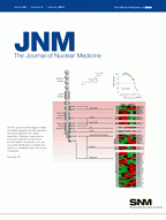REPLY: We very much appreciate the comments and suggestions of Yakushev and Fellgiebel on our paper ( 1), which was the first in a series we are publishing on in vivo human molecular imaging using our newly introduced ultra-high-resolution PET-MRI fusion system ( 2). Like Yakushev et al. ( 3), we have also noticed the importance of longitudinal differential metabolic activities, and we are preparing several experiments along that line. The results of some of these have already been reported ( 4).
Our paper was the first to demonstrate the capability of the new PET-MRI system for functional and metabolic study of the hippocampus not only along the horizontal axis but also along the longitudinal axis. In addition, the system measures and localizes the activity with the precision of 7.0-T MRI resolution—that is, resolution on the order of a few hundred microns, well suited to the study of subhippocampal activity. Consequently, with PET-MRI, one can measure functional and metabolic activity at a resolution sufficient to differentiate the subfields of the hippocampal regions—the dentate gyrus; cornu ammonis (CA) 1, CA2, CA3, and CA4; and subiculum—which could not previously be measured by any means. This in vivo human molecular imaging at subhippocampal resolutions will undoubtedly facilitate further exploration of not only the hippocampus but also many vital deep brain structures, such as the thalamus and brainstem, which have delicate structures requiring a similarly high-resolution imaging capability ( 5).
We wholeheartedly agree that analysis of the longitudinal axis of the hippocampus will clearly shed light on the mysteries of the hippocampal subfields. As suggested by Yakushev et al. ( 3), the previous 18F-FDG PET study of Ouchi et al. was limited in measurement of the glucose metabolism in the hippocampus mainly because of the poor resolution of the PET and MRI (1.5 T) scanners they used at that time ( 6). Studies can undoubtedly be extended to many cognitive neuroscience areas and to hippocampus-related diseases such as dementia and Alzheimer disease. We have already extended our hippocampal activity study to memory and dementia studies, which will certainly include investigation of the longitudinal axis of the hippocampus as suggested by Yakushev et al.
Age-dependent effects were purposely ignored in our study, because we were interested in performing a base study on young, healthy subjects. However, we will certainly extend our studies to age dependency, as well as to various disorders such as Alzheimer's disease. Assessment of age-dependent metabolic changes in the hippocampus will require large numbers of subjects. Our previous work was only to introduce the potential of the new state-of-the-art ultra-high-resolution PET-MRI system for studies of subhippocampal metabolic function. We fully agree that study of the longitudinal axis for age-dependent changes should be pursued, because such changes would be more sensitive to age, as has been observed in many previous studies ( 3, 7, 8).
- © 2011 by Society of Nuclear Medicine







